
|
Sale 72
February 2-5. 2013
| Lot |
Photo |
Description |
Realized |
Lot 1244 |
 |
1796. . JR-2, Rarity-4. NGC graded MS-64. Lovely antique multi-color toning. The dies of the JR-2 were used for this single die pairing. They seem to have held up well. In the early months of 1796, the Mint struck 22,135 from six die combinations.
The JR-2 is easily recognized with the obverse star 15 almost touching the drapery. R in LIBERTY is high and set too far left. On the JR-2 die marriage, the borders tend to be well struck. Of importance here is the fact the eagle is very well struck including a full head, eye, and beak detail, excellent claws and talons, and breast detail showing almost (but not quite) complete. Rich lavender-gray and gunmetal-blue patina embraces this carefully preserved and noteworthy example that is easily Condition Census-grade. A few minor handling marks in the field are mostly obscured by the lovely toning. Pop 19; 9 in 65, 7 in 66, 3 in 67.
Although the dime has been an essential part of the decimal coinage system until recent times when inflation has caused it to lose attention to the dollar-bill, it was one of the last coins issued by the United States Mint when operations first began. By the time it made its debut in 1796, as the Draped Bust/Small Eagle dime, the Mint had already been making copper cents and half cents for three years; silver dollars, half dollars and half dimes for two years; and even two gold coins-the eagle and half eagle-for a year. The only other coins delayed, like the dime, until 1796, were the quarter dollar and quarter eagle.
The Draped Bust/Small Eagle design by Mint Chief Engraver Robert Scot was used in 1796 and 1797. It features a buxom Liberty, her hair flowing and tied by a ribbon while her neckline is draped; all encircled by stars at the sides. The inscription LIBERTY appears above and the date below. The reverse depicts a small, spread-winged eagle perched upon clouds and surrounded by palm and olive branches. Encircling this is the motto UNITED STATES OF AMERICA. The coin carries no statement of value-curiously, the Mint Act of 1792 required that only the copper cent and half-cent be inscribed with denominations.
Pieces dated 1796 have fifteen stars--one for each state in the Union then. In 1797 some dimes were struck with sixteen stars (reflecting Tennessee's admission as the 16th state) and some with thirteen, symbolizing the thirteen original states. Such dies were prepared after the Mint abandoned the idea of adding an extra star for each new state.
Estimated Value $38,000 - 42,000.
View details and enlarged photos
| Unsold |
Lot 1245 |
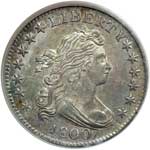 |
1800. . JR-2. Rarity-5. PCGS graded MS-63 CAC Approved. Beautiful steel blue toning with semi reflective fields. As an issue, the 1800 is one of the more underrated coins in the Draped Bust Dime series of 1796-1807. Survivors from an approximate mintage of just 21,760 pieces tend to be more elusive than most collectors (and even many numismatic professionals) realize, and the issue just does not appear at auction all that often. Of the two die marriages known to exist, JR-2 is rarer in an absolute sense, yet about as rare as JR-1 when we consider only Mint State examples.
According to the John Reich Collectors Society (Early United States Dimes: 1796-1807) only five examples of the 1800 JR-2 Dime are believed extant in Mint State. Whether or not the authors were aware of the present example when their 1984 reference went to print is not known to us, but there is no doubt that this coin is in very select company among survivors of this elusive die variety. A lovely piece, both sides exhibit soft silvery-blue undertones that backlight touches of delicate colored patination. The strike is a bit soft in the centers, as noted on the lovelock curl, but also in certain areas on the reverse, such as the neck and eagle�s breast with associated weakness on U of UNUM, but the overall impression is still appreciably sharp for a product of the early United States Mint. Satin-to-semi-Prooflike luster radiates forcefully as the coin rotates under a light. More importantly, there are no outwardly distracting abrasions to inhibit the eye appeal. An important prize for both the better-date type collector and the numismatist who specializes in Bust coinage. Pop 1; 1 in 63+, 1 in 64, 1 in 65, 1 in 66. (PCGS # 4470) .
For much of January and February, 1800, tributes to George Washington were held in cities and towns in the various states. Mason Locke Weems, an Episcopal clergyman, published The Life and Memorable Actions of George Washington, which went into multiple editions, the fifth of which (published in 1806) included the fanciful tale of young Washington and the cherry tree. Much of Weems' fiction passed into popular folklore. Hymns and Odes Composed on the Death of General George Washington, was published and included contributions from many sources, including Thomas Paine.
In the presidential election that year, Democratic-Republican Thomas Jefferson won 73 Electoral College votes as did Aaron Burr, followed by 65 for President John Adams and 64 for Charles Pinckney. After many more ballots, the opposition of Alexander Hamilton to Burr swung the majority to Jefferson's side in February 1801.
During the summer of 1800, the capital of the United States was moved from New York City to Washington, D.C., with 123 federal clerks participating in the move. Congress met in Washington for the first time on November 17, 1800, the same day President John Adams moved into the White House.
Estimated Value $45,000 - 50,000.
View details and enlarged photos
Check results on similar lots
| Realized
$51,750 |
Lot 1246 |
 |
1803 PCGS graded Genuine Fine Details. . JR-4, 3 leans away from 0. Surface damage. Nice even toning, a scarce early Draped Bust, Large Eagle dime (PCGS # 4473) .
Estimated Value $1,200 - 1,300.
View details and enlarged photos
Check results on similar lots
| Realized
$1,380 |
Lot 1247 |
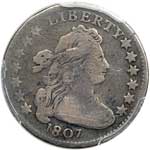 |
1807 PCGS graded Genuine VG Details. . JR-1. Tooled. Even grey toning. Only the one die variety this year, final issue with Draped Bust, Heraldic Eagle (PCGS # 4480) .
Estimated Value $600 - 650.
View details and enlarged photos
Check results on similar lots
| Realized
$604 |
Lot 1248 |
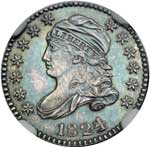 |
1824. 4 over 2. NGC graded Proof 65. Only 3-4 examples struck. Pop 2; 2 finer in 67. This is one of the rarest series in all of U.S. numismatics. This piece is softly struck in the center of the obverse as well as over a few of the eagle's neck feathers at the junction with the shield. This is a curious feature to see in a proof striking, and it is indicative of the state of technology that prevailed in the United States Mint during the early 19th century. The balance of the devices are sharply defined, and neither side reveals any distracting hairlines, contact marks or other blemishes. Evenly toned in charcoal-gray patina that lightens ever so slightly over the reverse eagle. With such a limited extant population, the proof 1824/2 Dime represents a fleeting opportunity whenever an example appears on the market.
The examples that are known to exist of this exceedingly rare coin are as follows:
1. Ex: Adolphe Menjou Sale (Numismatic Gallery, 6/1950), lot 174; Harold Bareford Collection Sale (Stack's, 10/1982), lot 166; Lovejoy Collection (Stack's 10/1990), lot 66.
2. Ex: Poof Collection (Bowers and Merena, 7/2005) lot 381.
3. Ex: 1992 ANA Sale (Heritage, 8/1992), lot 1676; 1993 ANA Sale (Heritage, 7/1993), lot 6187. Certified Proof-65 by NGC at the time of both sales.
4. Ex: Howard R. Newcomb, exhibited at the 1914 ANS Exhibition; William Cutler Atwater Collection (B. Max Mehl, 6/1946), lot 91; Floyd T. Starr Collection (Stack's, 10/1992), lot 353. Uncertified at the time of the Starr Collection Sale, but almost certainly now residing in a Proof -65 NGC holder.
Estimated Value $35,000 - 45,000.
View details and enlarged photos
| Realized
$41,975 |
Lot 1249 |
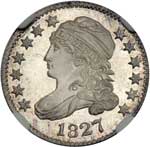 |
1827. NGC graded Proof 67 Star Cameo. Only 12 examples struck. Pop 1; none finer at NGC. The only piece graded in Proof Cameo by the service. This coin presents a very interesting scenario regarding the discussion of early American Proof coinage. When examining this specimen, perhaps the first thing we see is a group of diagonal marks extending from 11 o'clock to 5 o'clock across the reverse. These are clearly mint-made as the design elements have been struck over them; they are not a result of post-striking defacement. After the devastating fire at the Philadelphia Mint in January 1816, coinage was notably curtailed for two years during the repair process. Part of the repairs included an upgrade to a steam-powered roller machine; the previous model was horse-drawn. Ingots of silver (also, gold or copper) were heated and gradually passed through these rollers, somewhat akin to rolling cookie dough with a rolling pin. This gradually reduced the thickness of the metal until a large sheet (approximately 12 feet in length and 18 inches wide) was very close to the approximate thickness of the required coinage, in this case Dimes. At this point, the silver sheet was passed through a "drawbar," the final sizing process. Imagine a very hot sheet of soft silver passing through a narrow slit between two hardened steel blades. Any contact with these blades would cause filings and shards of metal to accumulate on the surfaces of the sheet, which in turn, could build up to create marks on the soft, smooth surfaces as the metal continued to pass through the "drawbar." Finally, a series of round cutters would literally punch blanks from the sheet of silver, like cookies being punched from dough. Most of the "blanks" were smooth, however, some possessed these telltale surfaces marks, incorrectly dubbed "roller marks" by many modern numismatists. They are actually "drawbar" marks. Perhaps, the single issue that is most often seen with "drawbar marks" is the 1902-S Morgan silver dollar. It is estimated approximately 20% of total production exhibits these marks to some degree.
Estimated Value $100,000 - 125,000.
Ex: Stack's Bareford Sale Lot 170 October 22, 1981.
View details and enlarged photos
| Realized
$86,250 |
Lot 1250 |
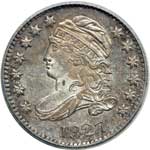 |
1827. SEGS graded Proof 62 Specimen/PR/JR-12. Nicely toned however the surfaces are just semi-reflective. We recommend careful examination.
This coinage date is the second of just four early dimes to exceed the one million coin mark with a mintage of 1,215,000 dimes. While 13 varieties are known from a combination of nine obverse and 10 reverse dies, one of these die marriages (JR-10) is only known in Proof. JR-12 as a business strike is one of the more common of thirteen die pairings for this issue, easily recognized by the low placement of the 7 in the date and the final A in AMERICA being solidly attached to the arrow (PCGS # 4544) .
Estimated Value $3,000 - 3,500.
View details and enlarged photos
Check results on similar lots
| Realized
$5,750 |
Lot 1251 |
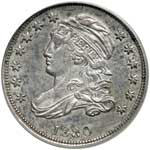 |
1830. SEGS graded Proof 62 Specimen JR-6. Lightly toned with nice reflective surfaces. Softly struck on the reverse. The United States Mint in 1828 instituted a new process of minting coins within a close, reeded collar to standardize diameters. This practice eliminated the time consuming method of manually placing reeding on the coin's edge. Greatly speeding up production, it allowed the coins to stack evenly and discouraged counterfeiting. The Mint's penchant for uniform designs dictated that all United States coins share one of three basic portraits of Liberty in those years: One for copper coins, a second for silver coins and a third for gold. The Capped Bust portrait of Liberty in use when Moore became Director was the one adopted by his father-in-law, the previous mint director, Robert Patterson. After Patterson hired John Reich as second engraver in 1807, Reich proceeded to redesign all the coins then in use (PCGS # 4549) .
Estimated Value $3,000 - 3,500.
View details and enlarged photos
Check results on similar lots
| Realized
$2,530 |
Lot 1252 |
 |
1837 No Stars Large Date. SEGS graded Proof 62. Flat Top 3. Ahwash-1. One of 30 Proofs minted. Nicely toned and well struck. The artistic No Stars design is by assistant engraver at the Philadelphia Mint, Christian Gobrecht. He'd been employed in the establishment for several years when the chief engraver, William Kneass suffered a stroke before completing a project to redesign the capped bust coinage. Kneass stepped aside to let Gobrecht provide new dies (based on sketches by artists Thomas Sully and Titian Peale). The design features Liberty seated on a rocky outcrop supporting a shield by her side with one hand while in the other she holds a pole surmounted by a liberty cap (PCGS # 4718) .
Estimated Value $3,000 - 4,000.
View details and enlarged photos
Check results on similar lots
| Realized
$4,830 |
Lot 1253 |
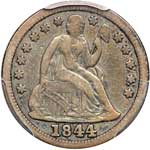 |
1844. PCGS graded VF-20. Only 72,500 minted of which merely 1,000 examples are estimated to have survived. Popular date. Even grey toning (PCGS # 4585) .
Estimated Value $500 - 550.
View details and enlarged photos
Check results on similar lots
| Realized
$541 |
Lot 1254 |
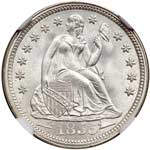 |
1855. NGC graded MS-68. Frosty white gem. Earlier appearing in a Heritage Auctions sale (Feb. 2008), "This beautiful Superb Gem type coin is close to brilliant, although faint tan toning is present here and there. Well struck aside from the reverse dentils near 6 o'clock. The preservation is outstanding, since careful evaluation is necessary to locate the occasional faint grazes. Arrows dimes were struck for only three years, 1853 to 1855. By 1849, West Coast gold was mined in sufficient quantity to increase the relative value of silver. Silver coins were promptly hoarded and melted. The Mint responded by reducing the weight of silver coins in 1853, which allowed them to circulate. Arrows were added to the date to denote the new tenor." A quick perusal of the Guide Book of United States Coins shows that the 1853 & 1854 production was prodigious to end the shortage of silver in circulation. However, by 1855, mintage declined to more normal levels; Mint State pieces are elusive and at this level, legendary: Pop 2; none finer at NGC .
Estimated Value $14,000 - 15,000.
View details and enlarged photos
| Realized
$16,388 |
Lot 1255 |
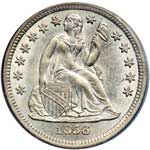 |
1856-S. PCGS graded MS-63 CAC Approved. Well struck and mostly untoned. A Premium Quality coin. Sharply struck, brilliant, and beautiful. This 1856-S dime is one of the very finest in existence. Only 70,000 were struck in 1856, this being the first year that the dime denomination was produced at San Francisco. There is no record of even a single example being intentionally saved by a numismatist. For that reason, virtually all have vanished over the years, and most of the few remaining are very much worn. The present coin is incredible in its importance, beauty and aspect, combining a numerical grade and, far more momentous (in our opinion), commanding eye appeal without peer. This certainly is a "must have" MS63 1856-S Seated Dime for an advanced collector! Pop 3; 2 in 64, 1 in 65. (PCGS # 4613) .
Estimated Value $14,000 - 15,000.
View details and enlarged photos
Check results on similar lots
| Unsold |
Lot 1256 |
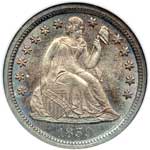 |
1859-O. NGC graded MS-66. CAC Approved PQ. Housed in an Old Holder. Well struck with semi-reflective fields. Looks like a Proof coin. With original mintage of 480,000 coins and a poor rate of survival, 1859-O is scarce in all Mint State grades. There is a sea of soft silvery luster under the original toning that includes areas of attractive (and iridescent) steel blue). The rich endowment of mint originality (semi-reflective, as mentioned) is undiminished in intensity, confirming the MS66 grade assigned, and the powerfully impressed features are free of even the smallest blemish. A significant opportunity for either the O-mint specialist, or the advanced Type collector.Pop 13; 4 finer, 3 in 67, 1 in 68.
Estimated Value $3,000 - 3,200.
View details and enlarged photos
| Realized
$3,450 |
Lot 1257 |
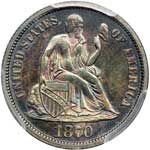 |
1870. PCGS graded MS-64. CAC Approved PQ. Comes with a NGC MS65 tag. Nicely toned. Pop 14; 9 finer, 5 in 65, 4 in 66 (PCGS # 4651) .
Estimated Value $450 - 500.
View details and enlarged photos
Check results on similar lots
| Realized
$690 |
Lot 1258 |
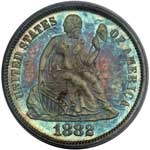 |
1882. PCGS graded Proof 65. CAC Approved. Wonderful multicolor toning, with iridescent to electric blue predominant. Only 1,100 struck. Pop 42; 28 finer (PCGS # 4779) .
Estimated Value $1,500 - 1,550.
View details and enlarged photos
Check results on similar lots
| Unsold |
Lot 1259 |
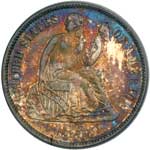 |
1885. PCGS graded Proof 65. CAC Approved. Lovely golden toning with deepeer reds and steel-blue. A gem. One of only 930 struck. Pop 56; 43 finer (PCGS # 4782) .
Estimated Value $1,500 - 1,550.
View details and enlarged photos
Check results on similar lots
| Unsold |
Lot 1260 |
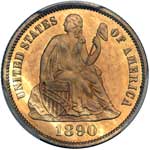 |
1890. PCGS graded Proof 65 Cameo. Only 590 struck. Light even gold toning on this glistening Cameo frosted Gem Proof. A real eye-opener for the Seated Dime buyer. Pop 13; 8 finer in 66CAM (PCGS # 84787) .
Estimated Value $1,500 - 1,550.
View details and enlarged photos
Check results on similar lots
| Unsold |
Lot 1261 |
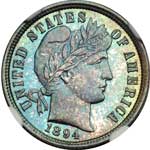 |
1894. NGC graded Proof 66. Lovely blue toning. Lustrous fields ripple with original mirror-deep bloom. Against this are set nicely frosted design elements. A solidly graded Proof 66 example, this coin displays above-average striking definition for a Barber Dime from this decade. This is to say that the strike is needle-sharp, not even a single detail missing. Only 972 struck. Pop 45; 36 finer, 27 in 67, 9 in 68.
Estimated Value $1,200 - 1,250.
View details and enlarged photos
| Realized
$1,438 |
Lot 1262 |
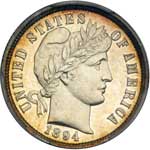 |
1894. PCGS graded Proof 64 Cameo. Mostly untoned except for some lovely golden amber shades at the margin. Nice cameo effect from the frosted devices. Only 972 minted. Pop 17; 40 finer (PCGS # 84878) .
Estimated Value $700 - 750.
View details and enlarged photos
Check results on similar lots
| Realized
$891 |
Lot 1263 |
 |
1901. PCGS graded Proof 64. Lovely blue and green toning on this choice, well cared for Proof (PCGS # 4885) .
Estimated Value $900 - 950.
View details and enlarged photos
Check results on similar lots
| Unsold |
Lot 1264 |
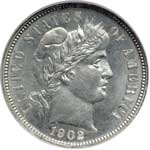 |
1902-O. NGC graded MS-65. Well struck, untoned, and semi-prooflike. Ice-cold white color streaks around the fields of this handsome O-mint Barber Dime, a low population example in this fine grade. Fortunately for the strike, it, like the luster, is outstanding. A better than average example with good details in the hair, LIBERTY and wreath. There are no bothersome abrasions or points of wear to reduce the Gem quality exemplified by the MS65 grade. Pop 7; 4 finer.
Estimated Value $3,000 - 3,200.
View details and enlarged photos
| Unsold |
Lot 1265 |
 |
1908. NGC graded Proof 67. Lovely toning on both sides. Only 545 struck. A high degree of mirror reflectiveness spins smoothly under deep toned surfaces of this sharp and elusive super Proof. The strike is crisp in all areas, full detail may be noted at the crown of leaves on Liberty�s cap and throughout the wreath on the reverse. Pop 16; 4 finer in 68.
Estimated Value $2,900 - 3,000.
View details and enlarged photos
| Unsold |
Lot 1266 |
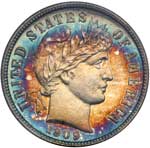 |
1909 PCGS graded Proof 66+ Cameo PQ CAC Approved. Wonderful rainbow toning on both sides. Spectacular strike definition and surface integrity. A bold Gem Proof. And one of only 650 struck. Pop 3; 3 finer, 2 in 67, 1 in 67+ (PCGS # 84893) .
Estimated Value $3,000 - 3,300.
View details and enlarged photos
Check results on similar lots
| Realized
$5,290 |
Lot 1267 |
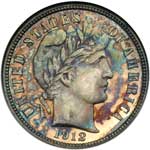 |
1912. NGC graded Proof 65. Housed in an Old Holder. Nice toning on both sides, the fields smooth and mirrored. Only 700 struck. Pop 36; 32 finer .
Estimated Value $1,350 - 1,400.
View details and enlarged photos
| Unsold |
Lot 1268 |
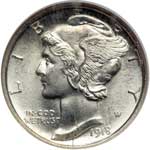 |
1918-D. NGC graded MS-65 Full Bands. A nice white coin. A remarkably gorgeous specimen of this date, one that pretty much was in short supply in Full Bands since it was struck. A coin that presents an outstanding opportunity for the Mercury dime specialist, or for that matter any enthusiast of rare coins. For one who must have the best for his or her collection, this 1918-D is it. Low population in the NGC register, its satiny surfaces display continuous luster and vibrant silvery highlights, fields, devices, with nary a single distraction is to be found even under magnification. Far from the norm for most coins from this issue, the strike is outstanding, with sharp detail in the centers. The central bands on the reverse are clear, nicely split and fully formed. A grand coin that would be draw attention to of any top-end Mercury dime collection, and one on which we expect forceful bidding to carry the day. Pop 9; 1 finer in 66FB.
Estimated Value $9,000 - 10,000.
View details and enlarged photos
| Realized
$10,638 |
Lot 1269 |
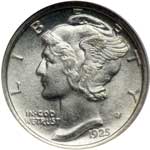 |
1925. NGC graded MS-66 Full Bands. Frosty and white. Pop 16; 3 finer in 67FB.
Estimated Value $700 - 750.
View details and enlarged photos
| Realized
$949 |
Lot 1270 |
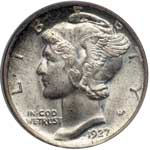 |
1927-D. PCGS graded MS-65 Full Bands. Lightly toned on both sides. A few light toning freckles. Crisp fresh silvery luster underneath the light color, virtually undisturbed mint luster that is consistent with this desirable MS65 grade. We leave behind the luster, though with reluctance since much more can be said about it, and move on to the devices. Even the most delicate detail seen on this coin shows it was made with uncommon exactness for the issue. This includes the key central cross bands which are complete. Unusual in 1927-D, very much so! Pop 29; 13 finer (PCGS # 4963) .
Estimated Value $5,000 - 5,500.
View details and enlarged photos
Check results on similar lots
| Realized
$5,175 |
Lot 1271 |
|
A Collection of Mercury Head Dimes 1916 to 1945-S. Missing a few late dates. From 1934 on the coins are mostly Unc. Many are nicely toned as well.
Estimated Value $900 - 1,000.
View details
| Realized
$3,910 |
Lot 1272 |
|
A Set of Mercury Head Dimes 1916 to 1945. Housed in a Dansco album and grades range from AG to AU. Missing the 1942/1.
Estimated Value $800 - 900.
View details
| Realized
$863 |
Lot 1273 |
|
Mercury Head Dime Sets 1916 to 1945. All three sets missing the 1916-D and 1942/1 overdate. Also included in this lot is a set of Roosevelt Dimes 1946 to 1964.
Estimated Value $600 - 700.
View details
| Realized
$834 |
Lot 1274 |
|
A Set of Mercury Head Dimes 1916 to 1945. Missing the 1942/1. The 1916-D is in About Good condition.
Estimated Value $500 - 550.
View details
| Realized
$575 |
Lot 1275 |
|
A Lot of Mercury Head Dimes. Consists of: 1921 (7), 1921-D (6), 1926-S (8), 1931-D (3), 1931-S (6), mixed date Mercury dimes mostly AU to Unc (252), 1943-P,D,S PCGS MS63FB, PCGS MS64FB, and PCGS MS64FB. A nice lot to figure. Many Gem FB coins hidden in the rolls.
Estimated Value $1,500-UP.
View details
| Realized
$2,185 |
Lot 1276 |
|
A Lot of U.S. Dimes. Consists of: Barber Dimes some better coins in this group (87), Seated Dimes (10), Mercury Dimes XF to Unc (81), 1921 (1 piece), 1931-D (1 piece), 1917-S (1 piece), 1949-S (1 piece), and 1950-S (1 piece). A nice lot.
Estimated Value $500-UP.
View details
| Realized
$920 |
Lot 1277 |
|
A Lot of U.S. Silver Dimes. Consists of: 1939-S BU Dimes (47 pieces), 1955-P,D,S (1 BU Roll each; 3 total Rolls), $11.20 face value in Mercury Dimes, and mixed date Mercury Dimes (10 pieces).
Estimated Value $1,500 - 1,600.
View details
| Realized
$2,013 |
Lot 1278 |
|
A Lot of Mercury Head and Roosevelt Dimes. Consists of: 1921 About Good (3), 1921-D About Good (2), 1926-S Good to VG (4), 1931-D Good to Fine (7), 1931-S Good to Fine (6), mixed dates VG to BU (110), and mixed date Unc Roosevelt Dimes (13). A lot that should be carefully checked.
Estimated Value $500 - 600.
View details
| Realized
$863 |
Lot 1279 |
|
A Collection of Proof Dimes, Quarters, and Half Dollars 1950 to 1964. Includes: 1964 Proof Halves all are Gem Proof coins in Capital Plastics holders. A total of 45 Proof coins. Many gems and some cameo coins.
Estimated Value $500 - 600.
View details
| Realized
$1,495 |
Lot 1280 |
|
A Lot of U.S. Unc Dime Rolls. Consists of: 1953-P (1 Roll), 1955-P (3 Rolls), 1955-D (3 Rolls), 1955-S (2 Rolls). Unchecked for Gems. Lot of 9 BU Rolls.
Estimated Value $950 - 1,000.
View details
| Realized
$1,150 |
Lot 1281 |
|
A Lot of Proof Dimes and Quarters. Consists of: 10¢; 1956, 1958 (2), 1959 (6), 1960, 1961 (23), 1962 (54), 1963 (15), 1964 (98), 25¢; 1959, 1960 (6), 1961 (52), 1962 (20), 1963 (18), and 1964 (9). A total of $26.50 face value .
Estimated Value $500 - 550.
View details
| Realized
$1,121 |
Lot 1282 |
|
A Lot of Silver Dimes and Quarters. Some of the Rolls are in Unc condition. $155 face value in Dimes and $40 face value in Quarters. A total of $195 face value .
Estimated Value $3,300 - 3,400.
View details
| Realized
$4,715 |
|
|